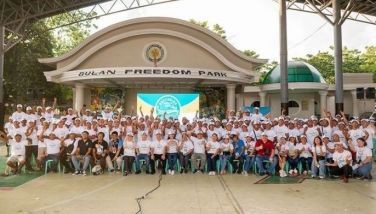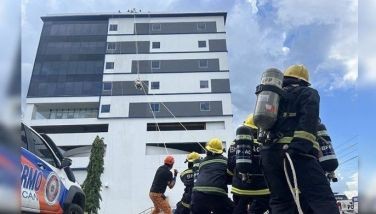UAE development:Progress in progress

ABU DHABI — The United Arab Emirates, a federal monarchy that is home and work place of some 500,000 overseas Filipinos is, literally, “progress in progress.”
This country of some 8.5 million with a per capita income of almost P2 million a year celebrates on Sunday its 41st National Day.
The festivities recall that day in 1971 when seven emirates clustered near the entrance of the Persian Gulf decided to unite to steady themselves as they let go of their British mentors and chart their own destiny.
From that time on, like the oil that keeps gushing out of the ground, it has been progress and more progress for the UAE — thanks to an enlightened leadership and an openness so uncharacteristic in these parts.
* * *
DIVERSIFICATION: Oil reserves of the UAE are the world’s seventh largest. The Philippines buys a large part of its crude requirement from it, making their trade balance in favor of the UAE.
But it has not just been oil that is fueling UAE’s phenomenal growth.
Purposeful diversification may help explain why oil that comprised 70 percent of its Gross Domestic Product in 1970 now accounts for only 29 percent. Its GDP has leapt from Dh6.5 billion in 1971 to Dh1,248 billion by the end of 2011, and is on track to grow by four percent in 2012. (One derham [Dh] is equivalent to around P11.20.)
Although the strength of the UAE economy lies in the development of its oil and gas industries, diversification has opened new investment areas.
Oil being a strategic economic item has not stopped it from investing heavily on renewable energy and nuclear power to reduce dependence on fossil fuel and expand its oil and gas exports.
Its progressive policies have been attracting businessmen and investors who value a country’s ease of starting a business.
* * *
OPENNESS: Philippine Ambassador Grace R. Princesa underscored in a phone interview the socio-political openness in this country.
The women, for instance, have ceased to be imprisoned in their abaya, a black over-garment covering most parts of their body. Western-style clothing is popular. A number of the liberated and better educated Emirati women hold key positions in government and other fields.
Foreign tourists can take pictures freely. In contrast, I have seen in another country north of here how a religious policeman grabbed the camera of a tourist who had aimed it at some local women and smashed it on the ground.
I have visited another neighboring country where the old monarch (later deposed in a coup by his own British- educated son who had breathed the libertarian air of the West) forbade eyeglasses and bicycles!
* * *
TOURISM: Princesa said one area of diversification is tourism, which is booming and responding to the accelerated buildup of the hospitality infrastructure.
On this visit, our Emirates Airlines Boeing-777 — on a direct nine-hour flight from Manila — landed in Dubai, a next-door capital a 90-minute drive away from here.
(This calls to mind the debate on whether or not the Macapagal International Airport in Clark Field, Pampanga, is too far even with a dedicated train/bus system to negotiate the distance in 45 minutes.)
* * *
BURJ KHALIFA: As we pulled out of the Dubai airport close to midnight, I asked the Pakistani at the wheel if we would see along the way the Burj Khalifa engineering marvel.
He pointed at a structure looming in the dark to our left. It reminded me of the eerie towers in the film “Lord of the Rings.”
The Burj Khalifa is, at 829.8 meters, the tallest manmade structure on earth. It grabbed the distinction from a 101-floor tower in Taipei.
Don’t look now, but the Chinese on the mainland may get even for their cousins in Taiwan by erecting soon a 220-floor skyscraper taller than the Burj Khalifa by 10 meters.
And while it took the Emiratis six years to complete their tower in Dubai, the Chinese boasted that they would put up theirs in just 90 days using innovative structural engineering.
* * *
NAME CHANGED: Burj Khalifa, which we will visit on Friday, used to be called Burj Dubai.
But when the construction got entangled in the 2007- 2011 global financial crisis and prospective tenants started to back out, its promoters stopped the hemorrhage by running for help to Abu Dhabi which was/is awash with petro dollars.
Abu Dhabi responded to the neighbor’s SOS signal, bankrolled the faltering project and - in a surprise move during its opening in 2010 - the project was rechristened Burj Khalifa to honor the Abu Dhabi president. The structure has become the centerpiece of a major tourism development in central Dubai. Soon that landmark will be joined by a $2.7-billion complex of five theme parks, including one focused on India’s Bollywood cinema industry.
The project will include 100 luxury hotels and a shopping mall (Attn: Henry Sy!) designed to be the biggest in the world.
* * *
MANILA MENTALITY: Their approach to attracting tourists and investors contrasts with Manila’s pushing tourism by capitalizing on gambling and making the Manila Bay reclaimed area the Las Vegas of the East.
It is unfortunate that Filipino official thinking gravitates toward the cheap and criminal. Planning is so shallow.
Dubai was able to rise from its handicap (compared to oil-rich Abu Dhabi) and succeeded in making the once-barren emirate an oasis of gold cup tourism.
The mutual assistance among the federated emirates is exemplary. Compare that with the Muslim Mindanao spectacle of billions being poured to that forsaken island — only to disappear into the pockets of local warlords.
* * *
RESEARCH: Past POSTSCRIPTs can be accessed at manilamail.com. Follow us via Twitter.com/@FDPascual. Send feedback to fdp333@yahoo.com
- Latest
- Trending

























